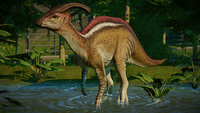Template:Era
Template:Dinosaur Infobox
| Well, this is more my speed... a Parasaurolophus. Its distinctive crested head presents a challenge to scientists... an evolutionary dead-end that we now realise is highly effective. This is what Jurassic research should be about. |
Parasaurolophus, or Parasaur for short, is a genus of hadrosaurid dinosaur that originated from Late Cretaceous North America.
Parasaurolphus fossils are first unlocked on Isla Tacaño then excavated from the Dinosaur Park Formation, Kirtland Formation, and Nemegt Formation.
Template:Heading2Bar Originating in Late Cretaceous North America, Parasaurolophus was among the first species cloned by InGen for Jurassic Park on Isla Nublar. By 1993, a herd of fifteen animals was present on Nublar, while thirteen were present on InGen's Site B facility on nearby Isla Sorna.[1] After the park was abandoned in 1993, continued attacks by Nublar's Tyrannosaurus had reduced the Parasaur population on the island to nine by 1994, with the remaining dinosaurs congregating close to other large herbivores for protection.[1]
Following the abandonment of Isla Sorna soon after the Jurassic Park Incident, the Parasaurolophus were left to fend for themselves. During the 1997 incident, several Parasaurolophus were briefly captured by InGen.[2]
In 2001, several Parasaurolophus were briefly encountered by those involved with the Isla Sorna Rescue Mission. They were found living alongside other herds of Corythosaurus.[3]
Upon the opening of Jurassic World in 2004, Parasaurolophus was one of the many species exhibited on Isla Nublar, living peacefully alongside other species of herbivore. Juvenile Parasaurs could be approached by visitors in the Gentle Giants Petting Zoo, while adults were seen congregating in the Gyrosphere Valley.[1][4]
Three years after the 2015 Isla Nublar Incident, many Parasaurolophus were transported to the Lockwood Manor in California, USA. These dinosaurs were later released into the wilds of Northern California by Maisie Lockwood.[5]
A year after the events at Lockwood Manor, a Parasaurolophus is seen drinking from a river by several people on a canoe.[6]
Template:Heading2Bar

A herd of Parasaurolophus.
Parasaurolophus is an average sized hadrosaur, but is otherwise distinguished by its prominent, curved crest. The base cosmetic gene of the Parasaurolophus has a light brown body, a white underbelly, a reddish back and crest, and dark brown stripes on its legs.
Unlocked sequentially after Corythosaurus, the dinosaur's requirements present the player with a moderate increase in complexity as it is the first hadrosaur they will encounter with a social group minimum requirement of 4. Its other requirements are relatively easy to manage, with a moderately long lifespan and fairly good resistance to illness, it differs in that it can be kept in a smaller exhibit than other dinosaurs. Its incubation cost is also relatively low.
Behavior

A herd of Parasaurolophus.
Parasaurolophus behaves similarly to the other hadrosaurs and is able to socialize and herd with them in normal circumstances. A herd is a necessity for this dinosaur due to their high minimum social requirements. They can otherwise mix well with other herbivorous dinosaurs with large maximum population limits.
Like all other hadrosaurs, Parasaurolophus is vulnerable to predation from all carnivores, meaning that its sole defense against predators is to avoid them.
Template:Heading2Bar Parasaurolophus was discovered in 1920 by a group from the University of Toronto in Alberta, Canada. The name Parasaurolophus means 'Near Crested Lizard', as early paleontologists originally believed this dinosaur was a direct relative of a genus called Saurolophus, though this is no longer accepted.
The dinosaur is known for its distinctive head crest, a point of discussion for many years since the genus was discovered. Some early paleontologists thought, among other theories, that it was used as a defensive weapon or as a way to push branches out of the way as it roamed through dense growth. The most common belief, especially in modern times and for all other crested hadrosaurs, is that the crests were used as an amplifying chamber for communication and for displaying to potential mates.
In-game, Parasaurolophus fossils can be found in the Nemegt Formation in Asia despite no specimens of the dinosaur having never been found there. This may be a reference to Saurolophus, which Parasaurolophus' name references, or to Charonosaurus, a large Asian hadrosaurid that greatly resembled Parasaurolophus.
Paleoecology
Parasaurolophus lived in a warm, swampy environment with lots of rivers and floodplains, alongside other dinosaurs such as the hadrosaur Corythosaurus, the ceratopsians Chasmosaurus, Pentaceratops and Centrosaurus, the ornithomimid Struthiomimus, the armored Ankylosaurus and Edmontonia and the tyrannosaurid Albertosaurus.
Template:Heading2Bar
- Coastal: Isla Tacaño Challenge Mode Any Difficulty Unlock
- 1997 D: Isla Sorna (1993) Challenge Mode Any Difficulty Unlock
Template:Heading2Bar
- Parasaurolophus was the second dinosaur revealed for the game, being seen hunted by the Tyrannosaurus in the first trailer for Jurassic World Evolution.
- Parasaurolophus was the eighth dinosaur to receive a Species Profile, on 9 March 2018.
- The base genome of the Parasaurolophus is based on its depiction in Jurassic World. In the Return to Jurassic Park DLC, it's based on its appearance in The Lost World: Jurassic Park, with alternate skins based on its depiction in Jurassic Park III.
- Parasaurolophus appeared in Jurassic Park: Operation Genesis, considered by many to be Jurassic World Evolution's spiritual predecessor.
Template:Heading2Bar
Template:Heading2Bar
- ↑ 1.0 1.1 1.2 http://www.dinosaurprotectiongroup.com/what-killed-the-gene-guard-act.html Dinosaur Protection Group - What Killed the Gene Guard Act
- ↑ The Lost World: Jurassic Park
- ↑ Jurassic Park III
- ↑ Jurassic World
- ↑ Jurassic World: Fallen Kingdom
- ↑ Battle at Big Rock, https://youtu.be/C7kbVvpOGdQ
Template:Heading2Bar Template:JWEDinosaurs
Template:Heading2Bar Parasaurolophus on Wikipedia






















